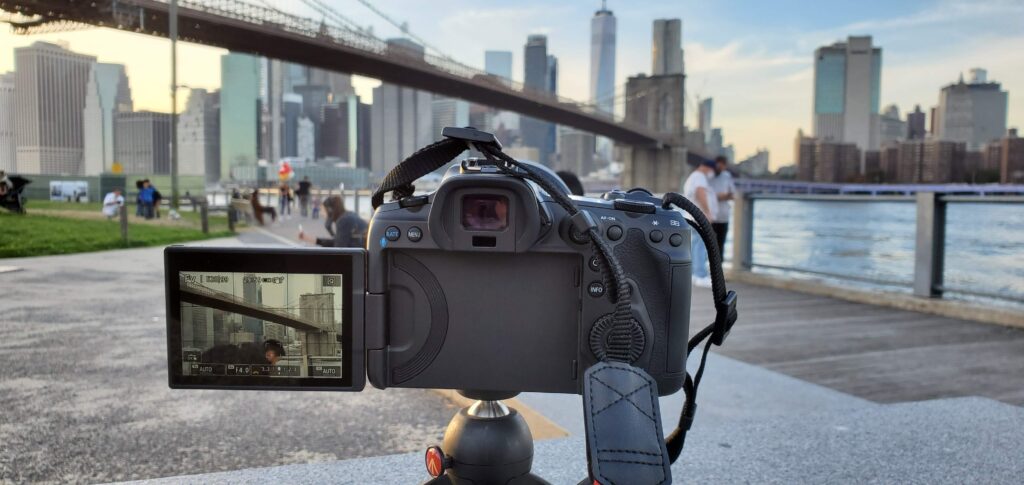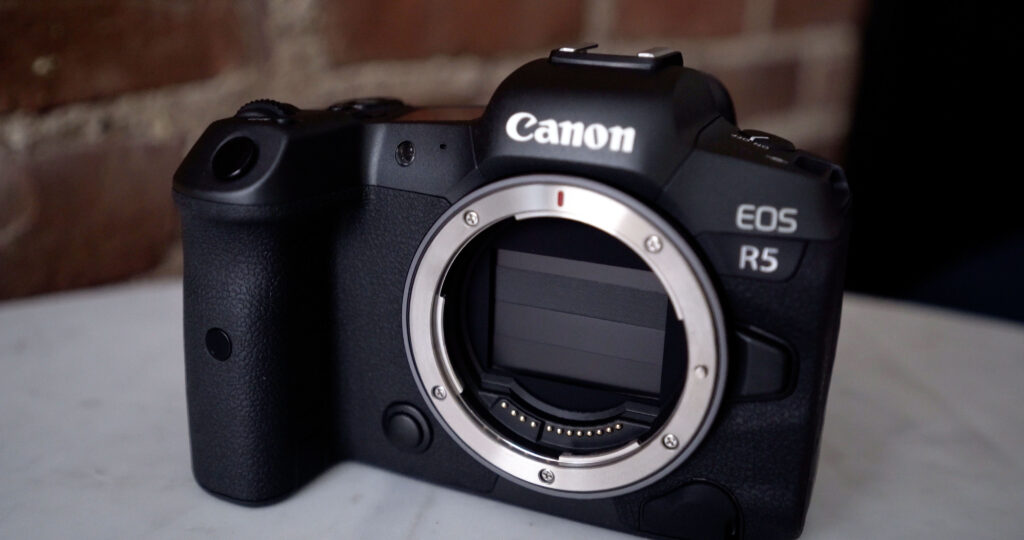When grids of LED lights started showing up on affordable panels a few years ago, I figured that’s what I’d be using for everything, and I even bought one of those crazy flex panels when they hit the market. You might have seen a guest review posted here, showing some really small lights that can do the job too. But with this new Sokani X60 RGB product, I think I’m ready to move into the world of more theatrical fresnel lighting, and this review (and associated video) will show you how to pull together the most cost-effective kit on the market including a stand, a diffuser, and a bag for everything.
This Sokani light is an expansion of their X60 product into full-color RGB, and it comes with a reflector that magnifies the output from its LED elements. They’ve added a glass protector that you can see screwed down over the light-emitting diodes, since these often get roughed around and the elements are fragile. It outputs 6,820 lux at 1 meter with the reflector on, which is a lot lower than its new close competitor, the Aputure Amaran 200x with 42,300 lux at indoor color temperature, but this is an RGB light that trades off lux for a full range of color, and I rarely turn up the output past 50% anyway. The Aputure costs 1-1/2 times more, too.

Another thing that Sokani added to their lineup with their version 2 X60, is a more secure mounting bracket. If you look closely, you’ll see ARRI rosette-like teeth that prevent the housing from pivoting down when you’re loading it with weight up front, like the diffuser you’ll see below.

The mounting bracket attaches to any standard light pole, with sockets for both horizontal and vertical positions. For powering up, you also get an AC adapter that plugs into the bottom of the light, but that side of the cabling is really short so it can’t reach the ground. For now, I’ve just set the power brick on top of the light, and its cables hold it in place, but I’ll need to use a clamp in the field, and I wish they made the cable longer on the delivery side since it’s much easier to extend an AC cable.
Sokani does sell an optional battery sled that takes two Sony L-series batteries, and it has a C-clamp so you can just fix it onto your light stand pole. It has a few more ports to power other accessory devices, too.
The back control panel display is bright enough for daytime and it shows you everything you need. At the end of the video associated with this post, I take you through every feature, showing you smartphone control on the same screen too.

Everything packs into an included carrying case with good padding. Since portability and low cost is what distinguishes this $200 product, I found a match in the perfect lighting stand for it, manufactured by Impact and sold for as little as $100. Its best feature is that it combines light stand and boom, with a mounting hole at the end so you can attach a counterweight. Impact includes a saddle bag that you can throw anything into for adding weight, like other batteries you brought with you, or bottles of water that you’ll be drinking when you pack up anyway.
The stand has a big knob to tighten the angle that doesn’t slip, and its magic trick is that the boom arm telescopes down into the vertical light stand! So you can skip the boom part if you don’t need it, and the stand adapter at the end can point straight up.

It’s reasonably small at 45 inches collapsed, but it can get up to 13 feet. For packing everything up but keeping to a low budget, there’s also a great padded bag that fits the stand perfectly from Ruggard costing under $60, way below anything else I could find. It’s perfect for holding the light stand, and also the diffuser that we’re adding to this kit.

For that, a light like this almost always has a standard so-called Bowen mount, and it’s just one latch with three sort of teeth that you insert and twist in to lock. What I’ve hooked on is the Aputure Lantern; at under $90, it’s the perfect pairing with this light. Acting like a so-called “China ball” or paper lantern, it provides very soft light with wide diffusion, and it’s often used overhead which makes that combo boom stand come in handy. My favorite feature is how it instantly sets up and breaks down: you just latch one center support loop into a hook that you can see peeking down into the bottom below, and those pre-installed “ribs” on the sides just warp into position. It literally takes about 5 seconds, and when collapsed, it’s nice and small, so we can fit it into that same Impact bag, even though it comes with its own.

You can see more uses of the light in Aputure’s own advertising video towards the end of mine, often overhead and often using black skirts that are also included to narrow down the light radius. But you can still mount it facing forward like a typical soft box for interviews too.
Finally, for those situations when you can’t plug into AC wall power, there’s a great battery by an offshoot of Sokani called ZGCINE. V-mount batteries used to be big bricks that would bog down your rig, but in the past few years, they have gotten increasingly smaller while maintaining or even exceeding the capacities of older products. The ZGCINE ZG-V99 is competitive with the new crop of portable V-mount batteries, but it leads the pack because of a few extra (and really important) features.
My favorite feature is the option to charge the battery using a now-standard USB-C PD (Power Delivery) source, such as a wall charger for mobile phones, or a power supply for some laptop computers. PD is a really important new technology because it uses a communication protocol to safely adjust the voltage sent to charge a device, after “handshaking” what the exact amount should be. So, this means that if it’s a typical mobile phone with a USB port, it’s 5V just like any other USB accessory. But if it’s this battery, PD sends 14.8V for correct charging speed and capacity. It’s about time! But if you want to charge via PD, you need to ensure that your charger is rated in the neighborhood of 45 to 65 watts.
ZGCINE needs to improve its documentation and labeling, however. The actual ports on the battery itself are faint on the orange rubber flaps, and you need to be careful to use one USB-C port for charging (on the long side), and the other for providing power to an accessory device (on the short side). Also, the D-tap port is labeled “out” but actually is ALSO an input charging port, so that you can charge the battery fastest and most conventionally using a D-tap charger via AC wall power (not included). The included instruction sheet does not help, either.
 Another great feature is a colorful OLED display showing the actual numerical percentage of battery power left, once you “turn on” the battery using a momentary circular orange inset switch. (Notably, I hear a physical clicking noise inside the battery upon pressing it, for a few seconds — is this safe?) In reality, the battery only needs to “power on” for charging via the USB Type A or Type C ports. The D-tap port is active at all times, anyway, regardless of whether you see the OLED display illuminated.
Another great feature is a colorful OLED display showing the actual numerical percentage of battery power left, once you “turn on” the battery using a momentary circular orange inset switch. (Notably, I hear a physical clicking noise inside the battery upon pressing it, for a few seconds — is this safe?) In reality, the battery only needs to “power on” for charging via the USB Type A or Type C ports. The D-tap port is active at all times, anyway, regardless of whether you see the OLED display illuminated.
 This is a great next step in the evolution of large batteries getting smaller! There are lots of inexpensive options for mounting this onto camera cages and light stands and tripods, treating the V-mount itself as a dummy connection (i.e., not using the standard V-mount bus pins which are unnecessary because of the battery’s other ports), and an adapter plate with clamp should cost you well under $20, making this product convenient for powering several devices on a camera rig at the same time, from one place.
This is a great next step in the evolution of large batteries getting smaller! There are lots of inexpensive options for mounting this onto camera cages and light stands and tripods, treating the V-mount itself as a dummy connection (i.e., not using the standard V-mount bus pins which are unnecessary because of the battery’s other ports), and an adapter plate with clamp should cost you well under $20, making this product convenient for powering several devices on a camera rig at the same time, from one place.



















